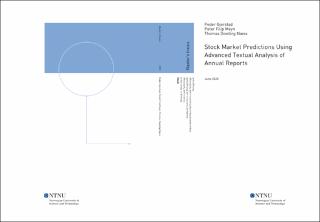| dc.contributor.advisor | Molnár, Peter | |
| dc.contributor.author | Gjerstad, Peder | |
| dc.contributor.author | Meyn, Peter Filip | |
| dc.contributor.author | Næss, Thomas Dowling | |
| dc.date.accessioned | 2021-09-14T17:06:53Z | |
| dc.date.available | 2021-09-14T17:06:53Z | |
| dc.date.issued | 2020 | |
| dc.identifier | no.ntnu:inspera:59706526:59721425 | |
| dc.identifier.uri | https://hdl.handle.net/11250/2776937 | |
| dc.description.abstract | Får investorer og analytikere med seg all informasjon som finnes i selskapers årsrapporter? I denne oppgaven finner vi at finansmarkedene på kort sikt overser viktig informasjon som er inneholdt i årsrapportene, og at denne informasjonen kan utnyttes gjennom teknikker for behandling av naturlig språk for å utgjøre en del av grunnlaget i verdsettelsen av børsnoterte selskaper. Vi analyserer 15,700 årsrapporter publisert av selskaper på aksjeindeksen S&P 500 i perioden 1994 til 2018, og finner at ettårig abnormal avkastning synker signifikant med mengden negativt sentiment i rapportene og med rapportenes filstørrelse. Vi finner derimot ikke slike mønstre på kort sikt, noe som kan indikere at det tar lang tid før finansmarkedene plukker opp denne typen informasjon. Ved å bruke Latent Dirichlet Allocation (LDA), finner vi at årsrapporter som fokuserer på "Helsetjenester", "Miljøkostnader" og "Finansielle planer" assosieres med høyere abnormal avkastning, mens økt fokus på "Søksmål", "Eiendomskontrakter" og "Utenlandsk valuta" ofte assosieres med det motsatte. Til slutt lager vi en modell for aksjehandel basert på metaalgoritmen AdaBoost og CART beslutningstrær for å vise at kun ved å benytte informasjon om sentiment, lesbarhet og temaer som rapporten tar opp, er det mulig å generere en årlig risikojustert avkastning på 3.8% på et datasett fra 2004 til 2018. | |
| dc.description.abstract | Are investors and analysts effective in interpreting the content in annual reports? This thesis suggests that financial markets in the short term overlook important information contained in the annual reports and that it is possible to use techniques from Natural Language Processing (NLP) on the annual reports to generate useful input when valuing listed companies. We analyze 15,700 annual reports published by S&P 500 companies in the period from 1994 to 2018 and find that one-year abnormal return decreases significantly with the amount of negative sentiment in reports and with the reports' file size. Interestingly, the effects are not reflected in stock prices several days after reports are published, suggesting that is takes a long time for the market to absorb this type of information. Through the use of Latent Dirichlet Allocation (LDA), we find that annual reports with a focus on "Health care", "Environmental cost" and "Financial plans" in their forward-looking statements tend to see higher abnormal returns, while focus on "Lawsuits", "Property lease" and "Foreign exchange" precede negative abnormal returns. Finally, a trading strategy based on sentiment, readability, and topics addressed in annual reports generate an annualized risk-adjusted return of 3.8% on an out-of-sample dataset from 2004 to 2018 | |
| dc.language | | |
| dc.publisher | NTNU | |
| dc.title | Stock Market Predictions Using Advanced Textual Analysis of Annual Reports | |
| dc.type | Master thesis | |
